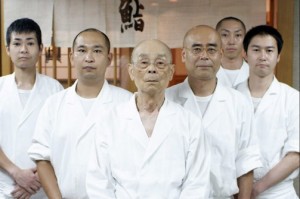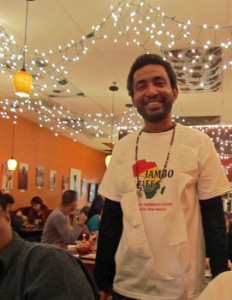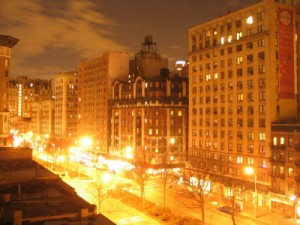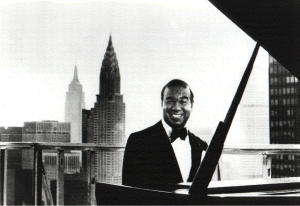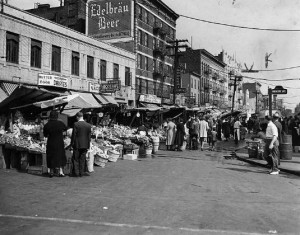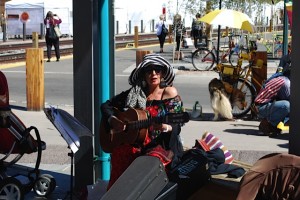Last night HG watched the Japanese firm, Jiro Dreams of Sushi. This is an appetite honing and thought provoking documentary about sushi chef Jiro Ono. Jiro, a spry and spruce 85-year-old gentleman owns and runs a sushi restaurant in Tokyo that has legendary status and three stars from Michelin. There are 10 seats and despite the fact that a sushi meal there costs each diner, at minimum, $300, reservations must be made months in advance. Essentially, this is a film about one man’s lifelong, obsessive search for perfection. And, it seems he has achieved it. He has also left a tough legacy to his sons (also sushi chefs) who strive to live up to his reputation while creating their own identities. The film left HG musing. Why are the two best food films (the other is Tampopo, an ode to ramen) Japanese? What is there in the Japanese character that drives a person to devote a lifetime to making the perfect pot, the perfect piece of calligraphy, the perfect flower arrangement — or the perfect portion of sushi? HG has the great good fortune of having a Japanese daughter-in-law, Exquisite Maiko. No, EM is not a slightly mad obsessive like Jiro Ono, but she is a mighty serious lady in the kitchen. HG has marveled at her knife skills when she worked wonders with a fresh filet of mackerel. HG has noted the symphony of sizzle as she prepared lighter-than-air tempura and the deftness of her fingers as she shaped wondrous gyoza and her patience in treating pork bellies to a three fold preparation technique culminating in an earthy, soul warming dish. EM’s performance is a one-woman show. It is wise not to get in her way. HG enjoys a dual pleasure. HG watches EM’s kitchen ballet. And, then he eats HG’s food. And, she doesn’t charge him 300 dollars.
Japanese Food (And) Film Mastery
October 13th, 2012 § 0 comments § permalink
Second Thoughts About Pro Football
October 12th, 2012 § 0 comments § permalink
It has long been HG’s custom (properly provisioned with vodka, ale and salumi) to watch a few hours of pro football every week. An autumn ritual. Now, HG is having second thoughts. HG has long felt that big time college football was a cynical branch of show business. The impressarios (the coaches) are paid millions. The producers (the colleges) make money and use successful football programs as a mechanism to raise money from alumni. The actors (the players) are exploited. They are paid nothing. They are often injured badly. And, when injured, they usually lose their scholarships. Only a miniscule number go on to a productive career in professional football… Bob Cox is an ex-journalist and publisher. Now he’s a New Mexico horseman and an ornament of the Abiquiu community. Best thing that’s happened there since Georgia O’Keefe. Bob’s witty and balanced view of life in these strange United States (Can one imagine Oxford or the University of Bologna spending millions on a televised sport?) can be found on his blog: anoldgringosgazette.com. Log on and read his observations about pro football — a sport where what would be criminal behavior in everyday life is applauded by fans and well compensated by owners. HG supports Bob’s views. The death of the remarkable Alex Karras highlights the viciousness of the sport. Besides being a talented athlete, Karras was an intelligent man, an original wit and an actor who gave pleasure to many. Pro football left him a physical wreck and, like so many other players, a sufferer from early dementia. The owners of pro football teams are, like most capitalists, dominated by greed. Witness their recent behavior against striking referees which made the game, for a time, a veritable farce. If they truly cared about the game and the players,they would invest some of their millions and invent helmets and other equipment that would keep players safe. If nothing is done, pro football will remain a brutal variation of Roman gladiators doing battle. Entertainment for bloodthirsty viewers and early dementia and wrecked bodies for the gladiators.
Like Yogi Says…
October 11th, 2012 § 0 comments § permalink
The New York Yankee sage, Yogi Berra (once HG’s neighbor in Montclair, NJ.), observed about a restaurant: “Nobody goes there anymore. It’s too crowded.” That’s the way HG felt about Santa Fe’s Jambo Cafe, located in a Cerillos Road strip mall. A small place, there was often considerable wait to taste the creative and unusual Caribbean/African cuisine. Well, HG was near there today and had a lust for vibrant coconut-peanut-chicken stew. HG discovered that Jambo has tripled in size. Same bright and colorful decor. Same smiling, warm and efficient service. The food? Better than ever. HG’s huge bowl of the aforementioned stew was brilliantly robust with many complex layers of hot, sweet and savory flavors. (If not hot enough for daring tastes, there’s a bottle of crushed Jamaican Scotch Bonnet peppers on each table. Let the unwary beware. Asked for a mini taste of the goat stew (yes, goat, and please don’t knock it until you try it) and the dish evoked Paris bistros and Rastafarian gourmet cooking. Don’t just concentrate on New Mexican green chile extravaganzas when you are in Santa Fe. Take a detour to Jambo.
Young New Yorkers Living in Expensive Closets: Read This And Weep.
October 10th, 2012 § 0 comments § permalink
Some 48 years ago (seems like yesterday). HG, BSK, their two adorable children, their live-in mother’s helper and their poorly trained but decorative standard poodle, lived in a 12th floor Upper West Side apartment with dramatic views of the Hudson River and the New Jersey Palisades. A very spacious residence. Big living room. Big, separate dining room. Nice windowed kitchen and pantry. Four bedrooms and three baths (one en suite). The rent: $274 a month (later raised to $292 and a similar apartment in the same building now rents for $15,000 a month). Ah, rent control, you lovely bit of legislation (of course, obtaining this rent controlled paradise involved some bribery, chicanery and corruption). This did not shock HG, a born and bred New Yorker. In those days the Upper West Side was affordable and diverse. There was still a heavy Jewish influence. Big time theater and entertainment folks (Abe Burrows, Leonard Bernstein, Isaac Stern and many more) lived on Central Park West alongside many affluent professionals and business persons. Side streets from Central Park West to Broadway were gritty (except for W. 67th Street, site of the Des Artistes apartment house and many studios of painters and musicians). Riverside Drive and the Avenues and cross streets west of Broadway were filled with intellectuals and creative types who had more brains and talent than money. Forget Greenwich Village. The Upper West Side was the home of professors, critics, novelists, dancers, journalists, composers, actors, musicians and school teachers. Lots of European intellectuals who had fled Hitler and many Holocaust survivors (the little, pale, Nobel Prize winning writer, Isaac Baashevis Singer, who lived on W. 86th Street, often wrote about them). The Heresford (West Side apartment houses often had British names, a touch of Anglophile class) where HG and BSK lived, had much artistic ferment. Among its residents were Peter Boyle (before Hollywood and TV fame); film composer Michael Small, the critic and editor Ted Solotaroff; Gary Null, the health and sex writer, guru and radio personality. There were also some Broadway dancers, the cantor of a major synagogue and lesser artistic lights. The Upper West Side was filled with movie theaters showing art films (the New Yorker, Thalia and Symphony) and plus the first run houses (Loew’s 83rd, the Beacon,etc.). Food was a neighborhood obsession. Zabar’s, of course, but also Murray’s (preferred by some smoked fish aficionados) and Barney Greengrass (unsurpassed sturgeon). Middle European restaurants like Eclair and dairy restaurants like Steinberg’s and Paramount. Gitlitz’ Delicatessen on Broadway and 78th ( much superior in HG’s informed opinion, to Katz’s, Carnegie or 2nd Avenue Deli). The jewel of the West Side was the Tip Toe Inn (on Broadway near 86th Street). A huge place with a huge menu. Everything was delicious and inexpensive (the New York Public Library has a nice collection of old menus….Here’s a link to Tip Toe’s 1954 menu. Be astonished). There was a rotisserie in the Bretton Woods Hotel (86th and Broadway) that barbecued ducks and chickens. Sunday dinners for HG and BSK often featured one of those juicy, crisp skinned ducks and an avocado-sweet onion-sliced orange salad. Chinese restaurants were clustered around Broadway and 96th and they were very good (the first Szechuan restaurant in New York was on Broadway and 95th). There were also some Cuban/Chinese places where you could get good shrimp dishes plus Moros y Cristianos (black beans and rice) Fairway didn’t exist but for those who liked to eat at home there were butchers like Endicottt Meats and Nevada Market (where you could get some exotic stuff including bear, in season). Good bakeries. Mom and Pop greengrocers. Citarella’s for fish. Broadway Nut Shop for sweets. Daitch Dairy (79th and Broadway) for tub butter and cheese. Bretton Wood Rotisserie for barbecued ducks. HG and BSK were not plutocrats but could afford all of these good things. Yes, the Upper West Side had lots of junkies, hookers, muggers and burglars. Their presence made West Siders feel superior to residents of the antiseptic Upper East Side. Now, let HG make you young folks really jealous. HG, BSK and family spent all summer plus spring and fall weekends at their Fire Island home. Built atop a dune it had panoramic views of the Atlantic Ocean and Great South Bay sunsets. The family bought it for $40.000. HG’s first Fire Island house (in 1959) cost $4,000 ($1,000 for land and $3,000 for two bedrooms, bathroom, kitchen, living room and deck). In 1960, HG added two more bedrooms, another bathroom and additional decking. Cost: $2,000. That’s right. The numbers for these Fire Island properties are correct. Read and weep.
Going, Going, Gone.
October 9th, 2012 § 0 comments § permalink
Bobby Short and Mabel Mercer are in the Great Golden Cabaret In Heaven. Two New York perennial cabaret venues — Oak Room at the Algonquin and Feinstein’s at the Regency — are closed or about to close. That leaves only the Cafe Carlyle as the last of the sophisticated New York supper clubs. These supper clubs were where the voices and songs of Mabel Mercer, Cole Porter, Rodgers & Hart, Harold Arlen and Noel Coward were idolized and celebrated. Where once hip folks of all ages went to those uptown Supper Clubs, the patrons now are increasingly ROF’s (Rich Old Fogeys) — obviously, a diminishing market. According to reports, the supper club scene in New York has shifted downtown with an emphasis on irreverence, drag and transgender performers. In this age of pornographic saturation, the old fashioned, bittersweet, romantic lyric seems a bit old fashioned. During the 50’s and 60’s there were scores of supper clubs in mid-Manhattan. Nelly Lutcher sang earthy tunes. Ted Straeter exemplified world weary sophistication. Spivy (a one name performer like “Hildegarde” and “Liberace”) and Dwight Fiske were queen and king of the double entendre (very tame stuff compared to much of today’s music and stand-up comedy ). HG’s favorite was Laurie Brewis who held forth at the Hotel Earle on Waverly Place in Greenwich Village.
During the 50’s, a date night for HG often consisted of martinis at Jack Delaney’s bar, big platters of seafood paella and a pitcher of sangria at one of the Village’s many good Spanish restaurants, a European movie at the Art movie theater — and then on to Brewis and Earle at midnight. The New Yorker Magazine described Laurie Brewis as “a fey bistro version of Noel Coward,” “The London Edition of the Show Business Encyclopedia” and a “bouncing Englishman playing his London portfolio and bringing back the tunes that everyone but he has forgotten” Laurie Brewis and his Piano. HG, his snifter of cognac, his Marlboro cigarette, his shapely female companion of the evening. Pleasant memories. Needless to say, HG always wore a shirt, tie, well pressed suit and shined shoes during these revels. One dressed to dine and date. Jeans were apparel for plumbers and cowhands.
Cultural Divide In Belmont
October 5th, 2012 § 2 comments § permalink
The great food writer, Waverley Root, once defined cuisines by the oil or fat they used in cooking — lard in Germany; butter in Paris, northern France, northern Italy; olive oil in the Provence, southern Italy and most countries bordering the Mediterranean. In the Belmont neighborhood of The Bronx where HG spent his very early childhood, there was a cooking divide between the predominantly Italian population and the Jewish minority. Olive oil, of course, was an Italian staple. HG’s Jewish Mom never used it. Chicken fat was used for cooking and often covered bread rather than butter. HG’s Mom also used a strange substance called Nyafat for frying. Nyafat was pareve — that is it was approved by rabbinical authorities for frying both meat and dairy products. Don’t know why HG’s Mom used it since she was not strict about observing Jewish dietary laws. She used Crisco or Spry for frying sometimes but usually relied on bubbling chicken fat. Butter was used for frying blintzes.
There was also a shopping divide in the neighborhood. HG’s Mom shopped on busy, noisy Bathgate Avenue for chicken, fish, fruit and vegetables. Bathgate Avenue was known for Jewish merchants, bargains and strenuous haggling. Bathgate Avenue is no longer a low end retail venue. It is now a city-subsidized industrial “park.” Italian women shopped on Arthur Avenue and Arthur Avenue (thank you, culinary gods) has remained unchanged over the years and is still one of New York’s best shopping areas for Italian food. Interestingly, one of the great stores on Arthur Ave for Italian food stuffs is a Jewish Shop (marked with a beautiful mosaic of a Star of David) called Teitl Brothers which has been there since 1915. Arthur Avenue butcher shops (with rabbits, whole lambs and piglets hanging in the windows) always fascinated little HG when HG’s Mom made one of her infrequent visits to the Avenue (she fancied the bread and pignolia cookies found there). The only other cultural interchange recalled by HG was HG’s Father swapping his home made cherry brandy (Vishniak) for a neighbor’s home made red wine. Belmont has remained an Italian (and newly Albanian neighborhood), proud of its ethnicity, culture and cuisine. Every weekend, nostalgic Italians from the suburbs (as well as every type of New Yorker and suburbanite) visit Belmont and Arthur Avenue to get a taste of what The Bronx used to be. And, on Arthur Avenue that taste is redolent of olive oil, tomatoes and garlic.
New Mexico Autumn
October 4th, 2012 § 0 comments § permalink
As HG and BSK sip their pre-dinner drinks, the fortunate duo look out at an array of trees sporting golden autumn regalia. Yes, New Mexico is alive with color during the sunny days and crisp nights. Sunday seemed like a perfect day for a spin to Abiquiu, the little town where Georgia O’Keefe worked and painted. Ghost Ranch, a few miles from her home, inspired some of her most remarkable works. So, it was off to Ghost Ranch where BSK took a score of photos. The mesas are extraordinary. Time has carved them into fairyland shapes. The colors.The forms. As HG and BSK strolled they found themselves alive in O’Keefe paintings. All of this, a leisurely 35-minute drive from their home.
The Products and People of the Santa Fe Farmers’ Market
October 3rd, 2012 § 0 comments § permalink
Saturday is Santa Fe Farmers’ Market shopping for HG and BSK. Pure joy. Yes, here are lots of peppers. The air is perfurmed by the beguling aroma of roasted green chiles.
But, there are lots of other things in the stalls. Little potatoes. Tomatoes. Baby eggplants. Turnips and radishes. Fresh garlic.
 And, at Mr. G’s stand, the best baby lettuce, frisee and Asian greens one can imagine. In the indoor section of the market there are breads, cheeses, pickles, quiches, etc. Much music. HG’s favorite performer is a dark haired lady who favors colorful hats. She sings in Spanish and French. Her French versions of “La Vie En Rose” and “Autumn Leaves” are riveting. Better than Piaf. As HG listens, the hungry old guy is plunged right into the heart of Paris.
And, at Mr. G’s stand, the best baby lettuce, frisee and Asian greens one can imagine. In the indoor section of the market there are breads, cheeses, pickles, quiches, etc. Much music. HG’s favorite performer is a dark haired lady who favors colorful hats. She sings in Spanish and French. Her French versions of “La Vie En Rose” and “Autumn Leaves” are riveting. Better than Piaf. As HG listens, the hungry old guy is plunged right into the heart of Paris.
